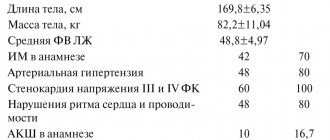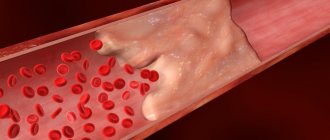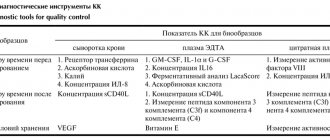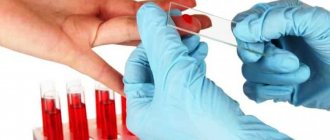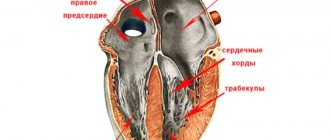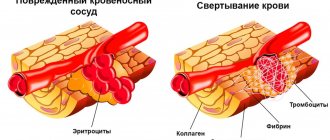Marina Olegovna Egorova
deputy Executive Director for CLD Issues at OMB LLC, Doctor of Medical Sciences
The article presents the features of the examination of a patient diagnosed with chronic myeloid leukemia under chemotherapy. The described clinical case and analysis of literature data indicate the particular importance of choosing a biomaterial for studying the electrolyte composition of a patient’s blood depending on the individual characteristics of the course of the disease, especially for patients with a significantly increased number of blood cells. The need to make special efforts to protect against false results of electrolyte concentrations and to pay attention to the features of the preanalytical stage of the study, including the choice of blood collection systems and preservatives, was noted.
The importance of monitoring the concentration of electrolytes in the blood, especially the concentration of potassium (K+), is justified by possible irreversible changes in myocardial contractile activity, incomparable with the vital activity of the myocardium, and is associated with neuromuscular dysfunction in both hyper- and hypokalemia [, ]. Hyperkalemia can cause cardiac arrest [], the most dangerous scenario for cardiac dysfunction.
Changes in the concentration of potassium in the blood can occur due to changes in diet, after exercise, or taking medications. The cause of false hyperkalemia in a blood sample can be hemolysis, violation of the temperature conditions of storage, and even a long, more than three hours, period of storage of a blood sample with a clot activator without centrifugation []. One of the possible situations of a falsely high concentration of potassium in the patient’s blood serum is pronounced cytosis (leukocytosis, thrombocytosis, erythrocytosis) during chemotherapy []. To explain this thesis, the article presents a clinical example describing the features of the examination of patient F., 28 years old, with a diagnosis of chronic myeloid leukemia under chemotherapy.
A comprehensive hematological analysis of venous blood was performed on a Gen's Beckman Coulter hematological analyzer. Analysis of potassium concentration in the blood was carried out using the method of indirect potentiometry on a Synchron Beckman Coulter biochemical analyzer. Venous blood was collected for research using closed-type Vacuette systems, with a clot activator and with lyophilized lithium salt of heparin (lithium heparinate, lithium heparin).
The results of a biochemical blood test demonstrate deviations from the reference limits not only for potassium, but also for other analytes. This article focuses specifically on hyperkalemia and establishing the truth of its cause.
As follows from the instructions for the drug [], one of the side effects of chemotherapy is a possible disturbance of cardiac activity. It should be noted that an increased concentration of potassium in a blood sample can be due to various reasons. First, hemolysis, injury to red blood cells during blood collection or processing (centrifugation) of the sample to obtain serum, should be excluded []. Today, many biochemical analyzers can determine the Serum Index to detect hemolysis, even if it is not visually verifiable []. In this case, based on the Serum Index determination, hemolysis in the test sample is excluded. A likely factor affecting potassium concentration may be the temperature of transportation and storage of the blood sample prior to testing []. Preferred is a stable temperature of 20–25 0C and potassium analysis within 5 hours after receiving the sample [], taking into account possible cases of hereditary mutation of ATPase and loss of potassium from erythrocytes when the temperature of storage/transport of the sample is lowered. In this case, the protocol for transporting and storing the sample before the study was followed.
Table 1
1.General information
Potassium is one of the key macroelements in the human body. This substance, especially in interaction with sodium, is necessary for the regulation of contractile activity of muscles (including the myocardium), water-salt, acid-base and energy balance, higher nervous activity, normal fermentation and metabolism, secretory activity of the endocrine glands, functioning liver and kidneys. Up to half of all salts in the body are potassium compounds, and most of them are contained in intracellular liquid spaces.
For all micro- and macroelements, including potassium, a certain concentration range must be observed.
Otherwise, both deficiency and excess lead to the development of severe, sometimes life-threatening conditions. Hyperkalemia, i.e. Excessive potassium levels are a typical example.
A must read! Help with treatment and hospitalization!
What foods contain potassium?
All products containing potassium (K) are usually classified taking into account the concentration of this useful mineral in them:
- low-potassium (100 mg of component per 100 g of product);
- with an average potassium content (150-200 mg per 100 g);
- with a high potassium content (260-400 mg per 100 g);
- saturated with potassium (more than 400 mg per 100 g).
Plant sources of potassium
Products of plant origin are a real storehouse of useful potassium compounds. Among them there is a wide variety of vegetables, fruits and berries containing this mineral.
For example, potassium in fruits is perfectly absorbed, since the combination of glucose and insulin is very effective, which promotes the transfer of potassium into cells.
Vegetables and fruits contain a lot of potassium and little sodium.
Potassium content in nuts and seeds:
| The product's name | Potassium content per 100g |
| Peanut | 658 mg |
| Walnut | 474 mg |
| Dried acorns | 709 mg |
| Pine nut | 597 mg |
| Cashew | 553 mg |
| Sesame | 497 mg |
| Almond | 748 mg |
| Sunflower seeds (seeds) | 647 mg |
| Pistachios | 1025 mg |
| Hazelnut | 445 mg |
Potassium content in cereals and grain products:
| The product's name | Potassium content per 100g |
| Buckwheat (grain) | 325 mg |
| Buckwheat (prodel) | 320 mg |
| Buckwheat (kernel) | 380 mg |
| Corn grits | 147 mg |
| Semolina | 130 mg |
| Oatmeal | 362 mg |
| Pearl barley | 172 mg |
| Wheat groats | 230 mg |
| Millet groats (polished) | 211 mg |
| Rice groats | 100 mg |
| Barley groats | 205 mg |
| Sweet corn | 270 mg |
| Pasta made from 1st grade flour | 178 mg |
| Premium flour pasta | 123 mg |
| Buckwheat flour | 577 mg |
| Corn flour | 147 mg |
| Oat flour | 280 mg |
| Oat flour (oatmeal) | 351 mg |
| Wheat flour 1st grade | 176 mg |
| Wheat flour 2 grades | 251 mg |
| Premium wheat flour | 122 mg |
| Wheat flour | 310 mg |
| Peeled rye flour | 600 mg |
| Rye wallpaper flour | 396 mg |
| Seeded rye flour | 200 mg |
| Rice flour | 50 mg |
| Oats (grain) | 421 mg |
| Oat bran | 566 mg |
| Wheat bran | 1260 mg |
| Wheat (grain, soft variety) | 337 mg |
| Wheat (grain, durum) | 325 mg |
| Rice (grain) | 314 mg |
| Rye (grain) | 424 mg |
| Oat flakes "Hercules" | 330 mg |
| Barley (grain) | 453 mg |
Potassium content in legumes:
| The product's name | Potassium content per 100g |
| Peas (shelled) | 731 mg |
| Green peas (fresh) | 285 mg |
| Mash | 1000 mg |
| Chickpeas | 968 mg |
| Soybean (grain) | 1607 mg |
| Beans (grain) | 1100 mg |
| Green beans) | 260 mg |
| Lentils (grain) | 672 mg |
Potassium content in fruits, berries, dried fruits:
| The product's name | Potassium content per 100g |
| Apricot | 305 mg |
| Avocado | 485 mg |
| Quince | 144 mg |
| Cherry plum | 188 mg |
| A pineapple | 321 mg |
| Orange | 197 mg |
| Watermelon | 110 mg |
| Banana | 348 mg |
| Cowberry | 90 mg |
| Grape | 225 mg |
| Cherry | 256 mg |
| Blueberry | 51 mg |
| Pomegranate | 150 mg |
| Grapefruit | 184 mg |
| Pear | 155 mg |
| Dried pear | 872 mg |
| Durian | 436 mg |
| Melon | 118 mg |
| Blackberry | 208 mg |
| Strawberries | 161 mg |
| Raisin | 830 mg |
| Fresh figs | 190 mg |
| Dried figs | 710 mg |
| Kiwi | 300 mg |
| Cranberry | 119 mg |
| Gooseberry | 260 mg |
| Dried apricots | 1717 mg |
| Lemon | 163 mg |
| Raspberries | 224 mg |
| Mango | 168 mg |
| Mandarin | 155 mg |
| Cloudberry | 180 mg |
| Nectarine | 201 mg |
| Sea buckthorn | 193 mg |
| Papaya | 182 mg |
| Peach | 363 mg |
| Dried peach | 2043 mg |
| Pomelo | 216 mg |
| Red rowan | 230 mg |
| Rowan chokeberry | 158 mg |
| Plum | 214 mg |
| White currant | 270 mg |
| Red currants | 275 mg |
| Black currant | 600 mg |
| Dried apricots | 1781 mg |
| Feijoa | 172 mg |
| Dates | 370 mg |
| Persimmon | 200 mg |
| Cherries | 233 mg |
| Blueberry | 51 mg |
| Prunes | 864 mg |
| Rose hip | 23 mg |
| Apples | 278 mg |
| Dried apples | 580 mg |
Potassium content in vegetables and herbs:
| The product's name | Potassium content per 100g |
| Basil (greens) | 295 mg |
| Eggplant | 238 mg |
| Swede | 238 mg |
| Ginger (root) | 415 mg |
| Zucchini | 238 mg |
| White cabbage | 300 mg |
| Broccoli | 316 mg |
| Brussels sprouts | 600 mg |
| Kohlrabi cabbage | 370 mg |
| Red cabbage | 302 mg |
| Cabbage | 238 mg |
| Savoy cabbage | 238 mg |
| Cauliflower | 210 mg |
| Potato | 568 mg |
| Cilantro (greens) | 521 mg |
| Watercress (greens) | 606 mg |
| Dandelion leaves (greens) | 397 mg |
| Green onion (feather) | 259 mg |
| Leek | 225 mg |
| Bulb onions | 175 mg |
| Carrot | 200 mg |
| Sea kale | 970 mg |
| Cucumber | 141 mg |
| Fern | 370 mg |
| Parsnip (root) | 529 mg |
| Sweet pepper (Bulgarian) | 163 mg |
| Parsley (greens) | 800 mg |
| Parsley (root) | 342 mg |
| Pomodoro (tomato) | 290 mg |
| Rhubarb (greens) | 325 mg |
| Radish | 255 mg |
| Black radish | 357 mg |
| Turnip | 238 mg |
| Lettuce (greens) | 220 mg |
| Beet | 288 mg |
| Celery (greens) | 430 mg |
| Celery (root) | 393 mg |
| Asparagus (greens) | 196 mg |
| Jerusalem artichoke | 200 mg |
| Pumpkin | 204 mg |
| Dill (greens) | 335 mg |
| Horseradish (root) | 579 mg |
| Garlic | 260 mg |
| Spinach (greens) | 774 mg |
| Sorrel (greens) | 500 mg |
Animal products containing potassium
Do not neglect animal products - they also contain potassium reserves.
Potassium content in meat, fish and seafood:
| The product's name | Potassium content per 100g |
| Vobla | 160 mg |
| Pink salmon | 335 mg |
| Red granular caviar | 90 mg |
| Pollock caviar | 60 mg |
| Black granular caviar | 80 mg |
| Squid | 280 mg |
| Flounder | 320 mg |
| Chum salmon | 335 mg |
| Baltic sprat | 380 mg |
| Caspian sprat | 600 mg |
| Shrimp | 220 mg |
| Bream | 265 mg |
| Atlantic salmon (salmon) | 420 mg |
| Mussels | 310 mg |
| Pollock | 420 mg |
| capelin | 290 mg |
| Meat (lamb) | 270 mg |
| Meat (beef) | 326 mg |
| Meat (turkey) | 210 mg |
| Meat (rabbit) | 335 mg |
| Meat (chicken) | 194 mg |
| Meat (fatty pork) | 230 mg |
| Meat (pork meat) | 285 mg |
| Meat (broiler chickens) | 236 mg |
| Navaga | 335 mg |
| Sea bass | 300 mg |
| River perch | 280 mg |
| Sturgeon | 280 mg |
| Halibut | 450 mg |
| Beef liver | 277 mg |
| Haddock | 300 mg |
| Beef kidneys | 237 mg |
| Crayfish | 250 mg |
| Carp | 280 mg |
| Salaka | 210 mg |
| Fatty herring | 310 mg |
| Lean herring | 31 mg |
| Medium salted herring | 215 mg |
| Mackerel | 280 mg |
| Som | 240 mg |
| Horse mackerel | 600 mg |
| Zander | 280 mg |
| Cod | 340 mg |
| Tuna | 600 mg |
| Acne | 230 mg |
| Oyster | 220 mg |
| Hake | 335 mg |
| Pike | 260 mg |
Potassium content in dairy products and egg products:
| The product's name | Potassium content per 100g |
| Acidophilus | 145 mg |
| Chicken egg white | 152 mg |
| Cheese cheese (from cow's milk) | 95 mg |
| Varenets 2.5% | 144 mg |
| Chicken egg yolk | 129 mg |
| Yogurt 1.5% | 152 mg |
| Yogurt 3.2% | 147 mg |
| Kefir | 146 mg |
| Kumis (mare's milk) | 77 mg |
| Low-fat kumiss (from cow's milk) | 146 mg |
| Milk | 146 mg |
| Goat milk | 204 mg |
| Yogurt 2.5% | 144 mg |
| Ryazhenka | 146 mg |
| Cream 10% | 124 mg |
| Cream 20% | 109 mg |
| Cream 35% | 90 mg |
| Sour cream 10% | 124 mg |
| Sour cream 15% | 116 mg |
| Sour cream 20% | 109 mg |
| Sour cream 25% | 100 mg |
| Sour cream 30% | 95 mg |
| Cheese "Adygei" | 70 mg |
| Cheese "Dutch" 45% | 100 mg |
| Camembert cheese | 75 mg |
| Parmesan cheese | 92 mg |
| Cheese "Poshekhonsky" 45% | 95 mg |
| Cheese "Roquefort" 50% | 110 mg |
| Cheese "Russian" 50% | 88 mg |
| Sulguni cheese" | 100 mg |
| Chees Feta" | 62 mg |
| Cheddar cheese 50% | 116 mg |
| Swiss cheese 50% | 100 mg |
| Gouda cheese | 121 mg |
| Cottage cheese 18% (fat) | 112 mg |
| Cottage cheese 2% | 78 mg |
| Cottage cheese 4% | 112 mg |
| Cottage cheese 5% | 112 mg |
| Chicken egg | 140 mg |
| Quail egg | 144 mg |
Among all the listed products, we will highlight the TOP products in terms of potassium content, availability, ease of preparation and absorption by the body. Food products containing potassium in large quantities
- Potato
One medium potato contains 900 mg of potassium. By eating just one potato as a side dish for lunch, you can get a little more than 1/5 of your daily potassium requirement. To absorb potassium, give preference to baked potatoes.
Potatoes also contain vitamin C, vitamin B6, iron, and fiber (especially in the skin). When cooled, potato starch nourishes beneficial intestinal microflora.
- Sun-dried tomatoes
Fresh tomatoes also contain potassium. But there is much more of it in dried tomatoes or tomato paste. It is better to prepare these products yourself or choose them in a store with a good composition - without added sugar and preservatives.
We recommend
"Can food heal people: the power of good nutrition" Read more
A cup of these tomatoes contains 1,800 mg of potassium, which is about 40% of the daily recommended amount.
In addition, tomatoes contain a lot of fiber, vitamin C, vitamin E, improve the digestive and immune system and are good for the heart.
- Beans
Red and white beans are equally beneficial for the body. One cup of red beans contains 600 mg, white beans - 1,000 mg. Beans are high in fiber, protein and iron. It can be added to soups and salads.
- Dried apricots
The concentration of nutrients contained in fresh apricots increases when dried. Therefore, 100 grams of dried apricot contains 1.162 mg of potassium.
- Prunes
In addition to potassium (686 mg in ½ cup), prunes contain vitamins B1, B2, C, magnesium, phosphorus and iron.
- Avocado
One avocado contains approximately 975 mg of potassium, as well as magnesium, phosphorus, iron, zinc, various vitamins and healthy fats, which are so important for heart health and good skin condition.
- Salmon
In 100 grams you can find 420 mg of potassium - this is more than in any other fish. In addition, red fish is rich in omega-3 and vitamin D.
- Spinach
An excellent side dish for fish and meat dishes, as well as a frequent ingredient in the most delicious smoothies, it contains 774 mg of potassium per 100 grams.
- Pumpkin
There are many varieties of pumpkin, and the amount of potassium depends on this. For example, 100 grams of cooked acorn squash contains 437 mg, and winter squash contains 448 mg.
- Oranges
In addition to vitamin C and B vitamins, folic acid, oranges also contain potassium. With one glass of juice you will get about 473 mg of potassium.
2. Reasons
It would be logical to assume that hyperkalemia is caused by excessive consumption of potassium-rich foods, for example, dried fruits, legumes, potatoes, bananas, etc. However, in reality this is extremely rare: the body’s daily need for potassium is quite large (up to 5 g in adults), and with normal metabolism the balance is easily restored through the excretion of potassium in the urine.
Thus, one of the main factors in the development of hypercalcemia is disorders of the kidneys (chronic renal failure, diabetic nephropathy, etc.), when potassium excretion becomes difficult and it begins to be retained in the body. This can be caused, in particular, by hypocorticism (Addison's disease) - chronic functional insufficiency of the adrenal cortex, in which the kidneys simply do not receive the appropriate hormonal “commands”.
Another group of reasons is associated with long-term use of medications that contain potassium or prevent its excretion.
The massive release of potassium from cellular fluids into the bloodstream is accompanied by severe polytrauma with crushing of large volumes of muscle tissue, drug overdose, and extensive burns.
The progressive accumulation of potassium in the body can also be caused by pathologically rapid and intense hemolysis (decomposition of red blood cells) in anemia and some other diseases.
Rarely, hereditary hyperkalemia is recorded - familial hyperkalemic periodic paralysis.
Visit our Therapy page
3. Symptoms and diagnosis
The clinical picture of hyperkalemia is not specific enough, so preliminary, presumptive diagnosis requires a doctor to have a lot of experience, attention and vigilance in this regard. Most often, changes in the ECG in combination with patient complaints of tachycardia (accelerated heartbeat), general malaise and constant weakness cause alarm. In more severe cases, cardiac abnormalities caused by excess potassium may take the form of arrhythmia, asystole, ventricular fibrillation, and ultimately cardiac arrest.
The diagnosis is established by comparing the existing clinical manifestations, the electrocardiographic picture and the results of laboratory tests (determining the concentration of potassium in the blood plasma). Depending on the most likely causes, an additional specialized examination is prescribed - for example, nephrological or endocrinological.
About our clinic Chistye Prudy metro station Medintercom page!
Potassium: What to do if your levels are too low?
Potassium levels may also drop too low. Doctors call this condition hypokalemia. Hypokalemia usually occurs due to another underlying medical condition that must be diagnosed by a doctor.
Possible causes of hypokalemia include:
- kidney disease
- certain medications, such as diuretics or laxatives
- excessive vomiting or diarrhea
- intestinal obstructions or infections
Symptoms of hypokalemia may include:
- muscle weakness
- metabolic acidosis
- heart rhythm disorder
- constipation
- breathing disorder
A doctor can diagnose hypokalemia using blood and urine tests. Hypokalemia is treated by treating the underlying cause and replacing potassium and fluids.
4.Treatment
With moderate and severe severity, hyperkalemia requires emergency intensive care due to the threat of cardiac arrest. One of the emergency measures is the intravenous administration of a special solution (calcium, insulin, glucose), but its effect is short-lived, and after relief of life-threatening symptoms, further therapy is required. Potassium-absorbing sorbents are prescribed (which ensures its excretion in feces); diuretics are used if renal function is preserved. Stop taking any medications that in one way or another affect the circulation of potassium in the body. Limit potassium intake from food. Since hyperkalemia is almost always secondary, a diagnostic examination (if the cause of the detected hyperkalemia is unknown) and treatment of the underlying disease are mandatory.
